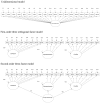The brief family relationship scale: a brief measure of the relationship dimension in family functioning
- PMID: 22084400
- PMCID: PMC3292682
- DOI: 10.1177/1073191111425856
The brief family relationship scale: a brief measure of the relationship dimension in family functioning
Abstract
The Relationship dimension of the Family Environment Scale, which consists of the Cohesion, Expressiveness, and Conflict subscales, measures a person's perception of the quality of his or her family relationship functioning. This study investigates an adaptation of the Relationship dimension of the Family Environment Scale for Alaska Native youth. The authors tested the adapted measure, the Brief Family Relationship Scale, for psychometric properties and internal structure with 284 12- to 18-year-old predominately Yup'ik Eskimo Alaska Native adolescents from rural, remote communities. This non-Western cultural group is hypothesized to display higher levels of collectivism traditionally organized around an extended kinship family structure. Results demonstrate a subset of the adapted items function satisfactorily, a three-response alternative format provided meaningful information, and the subscale's underlying structure is best described through three distinct first-order factors, organized under one higher order factor. Convergent and discriminant validity of the Brief Family Relationship Scale was assessed through correlational analysis.
Keywords: Alaska Native; cohesion; conflict; expressiveness; family climate; family relationships.
Figures
References
-
- Graham JM. Congeneric and (essentially) tau-equivalent estimates of score reliability: What they are and how to use them. Educational and Psychological Measurement. 2006;66:930–944.
-
- Jackson T, McKenzie J, Hobfoll SE. Communal aspects of self-regulation. In: Boekaerts M, Pintrich PR, Zeider M, editors. Handbook of self-regulation. San Diego, CA: Academic Press; 2000. pp. 275–300.
-
- Lee G, Dunbar SB, Frisbie DA. The relative appropriateness of eight measurement models for analyzing scores from tests composed of testlets. Educational and Psychological Measurement. 2001;61(6):958–975. doi: 10.1177/00131640121971590. - DOI
-
- Ma HK, Leung MC. The adaptation of the Family Environment Scale to Chinese children and adolescents in Hong Kong. International Journal of Psychology. 1990;25:545–555. doi: 10.1080/00207599008247882. - DOI
Publication types
MeSH terms
Grants and funding
LinkOut - more resources
Full Text Sources


